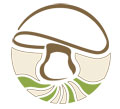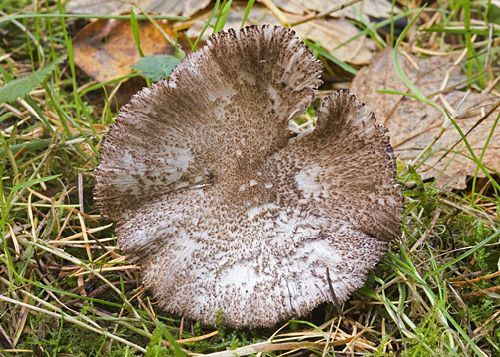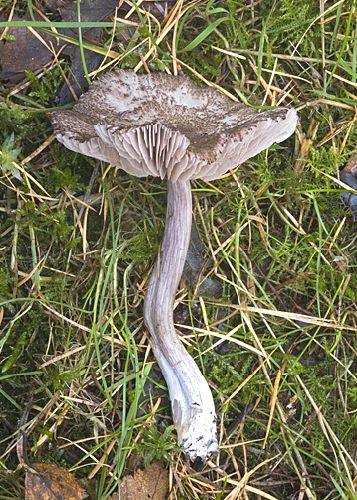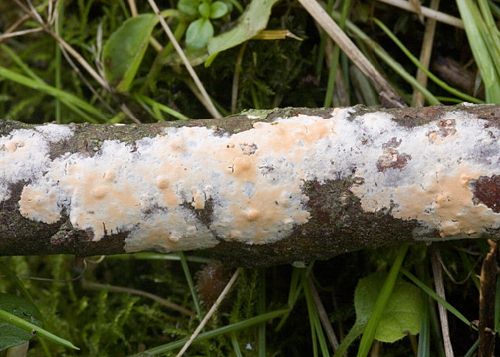The Chase, Woolton Hill
Sat 31 Oct 2009
Field event ID HF0920
OS Grid areas: SU4462
Weather: Following some recent rain fungi were more abundant than they have been for a long time.
New Records:
New to VC12: Peniophora erikssonii, Ciboria viridifusca and Entoloma scabiosum
Report: (Sue and Alan): After a brief venture into Berkshire Sue Rogerson and Alan Lucas joined the rest of the party including Heather Fisher, the National Trust warden for the site. Heather gave us a brief overview of the area before we set off. The site was a good mixture of habitats including grassland, alder carr, mixed hard and coniferous woodland and was well worth the journey for those living in the south of the County.
Eric's initial excitement at finding what he thought was Ishnoderma resinaceum on Fagus and had led to him rushing after Alan, waned once he realised the tree was after all a conifer. There were however some other unusual finds including Stropharia inuncta, Peniophora erikssonii, Ciboria viridifusca and Entoloma scabiosum. The latter three were all new to VC12 and the Stropharia is a striking but not common find. Entoloma scabiosum, a great find by Chris Gaffney, has a scaly cracking brown cap looking more like a lepiota cap than an entoloma. Although this was a new species to the group Sue had previously found it in Dorset on a BMS foray.
Note SJS: Chlorophyllum (Macrolepiota) rhacodes which has been reported in recent weeks is a species causing much angst to me and others at the moment. There has been a reassignment of names in this group described in an article in Field Mycology Vol 7(4) by Else Vellinga who has carried out a lot of the recent DNA work. In addition Funga Nordica has a new key and John Bailey has an article in The Forayer. At the recent BMS Suffolk foray John and Doreen Bailey found some further specimens of Chlorophyllum which now make them doubt the photos in their article - in fact all photos in the popular books need re-interpreting in the light of Vellinga's work. This is of some importance as it is commonly eaten species which is known to cause 'gastric upsets' in some people, due I now suspect to incorrect identification. As I understand it neither of the photographs in Phillips (2006), for example, are of Chlorophyllum rhacodes but one is Chlorophyllum brunneum (126a) (poisonous) and the other Chlorophyllum olivieri (126b) (edible). See what you think. This highlights the value of noting the book/key used for identication when submitting records, something we are all guilty of not doing I'm sure.
Species list: Agaricus sylvaticus, Agrocybe rivulosa, Amanita citrina var. citrina, Amanita muscaria var. muscaria, Amanita rubescens var. rubescens, Armillaria mellea, Armillaria ostoyae, Auricularia auricula-judae, Baeospora myosura, Bolbitius titubans var. titubans, Boletus badius, Boletus cisalpinus, Bulbillomyces farinosus, Bulgaria inquinans, Bulgaria inquinans, Byssomerulius corium, Calocera cornea, Calocera pallidospathulata, Calocera viscosa, Calyptella capula, Chlorociboria aeruginascens, Chlorophyllum rachodes, Chondrostereum purpureum, Ciboria viridifusca, Clitocybe gibba, Clitocybe nebularis, Coprinellus micaceus, Crepidotus cesatii, Crepidotus cesatii, Crepidotus epibryus, Crepidotus luteolus, Crepidotus mollis, Crepidotus variabilis, Crepidotus versutus, Daedalea quercina, Daedaleopsis confragosa, Daldinia concentrica, Entoloma scabiosum, Exidia recisa, Fistulina hepatica, Galerina marginata, Ganoderma australe, Gymnopilus penetrans, Gymnopus dryophilus, Gymnopus peronatus, Heterobasidion annosum, Hohenbuehelia atrocoerulea, Hygrophoropsis aurantiaca, Hyphoderma setigerum, Hyphodontia sambuci, Hypholoma fasciculare var. fasciculare, Hypoxylon fragiforme, Inocybe geophylla var. geophylla, Inocybe geophylla var. lilacina, Inonotus hispidus, Ischnoderma benzoinum, Kuehneromyces mutabilis, Laccaria amethystina, Laccaria laccata, Lacrymaria lacrymabunda, Lactarius glyciosmus, Lactarius quietus, Lactarius serifluus, Lactarius turpis, Lentinus brumalis, Lepiota cristata, Lepista nuda, Lycoperdon perlatum, Macrotyphula fistulosa var. contorta, Macrotyphula fistulosa var. fistulosa, Mensularia radiata, Meripilus giganteus, Mycena epipterygia, Mycena galericulata, Mycena galericulata, Mycena galopus var. galopus, Mycena haematopus, Mycena pelianthina, Mycena pseudocorticola, Mycena pura, Mycena sanguinolenta, Nectria cinnabarina, Oudemansiella mucida, Panaeolina foenisecii, Panaeolus cinctulus, Panaeolus papilionaceus var. papilionaceus, Paxillus involutus, Peniophora erikssonii, Peniophora laeta, Peniophora quercina, Phaeolus schweinitzii, Phleogena faginea, Pholiota alnicola var. alnicola, Physisporinus sanguinolentus, Piptoporus betulinus, Pleurotus ostreatus, Pluteus cervinus, Postia ptychogaster, Psathyrella piluliformis, Rhodocollybia butyracea, Rhodocollybia maculata, Rickenella fibula, Russula aeruginea, Russula betularum, Russula betularum, Russula grisea, Russula ochroleuca, Russula puellaris, Schizopora paradoxa, Scleroderma citrinum, Scutellinia scutellata, Skeletocutis nivea, Sparassis crispa, Steccherinum fimbriatum, Stereum gausapatum, Stereum hirsutum, Stereum rugosum, Stereum subtomentosum, Stropharia inuncta, Suillus luteus, Trametes versicolor, Tremella mesenterica, Trichaptum abietinum, Tricholomopsis rutilans, Vuilleminia comedens, Xerula radicata, Xylaria hypoxylon




